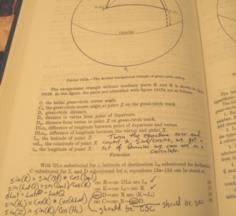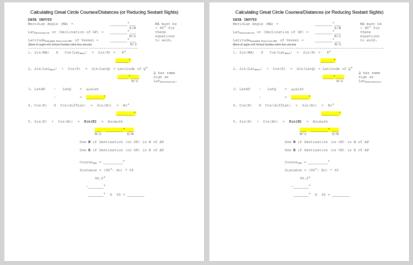
NavList:
A Community Devoted to the Preservation and Practice of Celestial Navigation and Other Methods of Traditional Wayfinding
From: UNK
Date: 2015 Mar 23, 18:21 -0000
I’m very interested in this. Have done hundreds of cel nav calculations over the last few years, mainly with cylindrical rules such as Bygrave , Fuller and less so with Otis King (this only does multiplication and division, no trigs, but good to 4 places). My 1930s Fuller, I inherited from granddad and dad (Perkins design engineer). A beauty!
My homemade Fullers (with trig) give 4-7 place accuracy, and most of my Hcs and even lunars are as good as a calculator and take about the same time.
I’ve never had a circular so no idea how accurate they are. I think Hanno is building one?
My ancient school boy Thornton 10” linear (date 1960s) is only accurate to max 3 places but I’ve been surprised at the results I have managed with both cosine formulae and Doniol multiplication step.
Could some mathematician out there explain why 3 digit accuracy rules seem to give better results than I , as a non mathematician would expect? (thought you needed at least 4 place accuracy?)
I’m just completing my definitive homemade Brown –Nassau Spherical computer, which is a kind of circular slide rule, but based on moving graphs of altitudes, decs, lats and Az, not log scale numbers.(see previous posts on this). Initial results suggest accuracy for Hcs of 2-5” and very simple and quick (under 2 minutes). Details to follow in next week.
I’ve also been looking at various graphical methods like Breed, recently discussed (by the way, recommend his really interesting book from the 50s). They are good but a lot slower than any of my slide rules and in particular the BN which beats everything for speed and simplicity, including calculators. Pretty well as quick as a computer /Smart phone cel nav program. I’m next going to try the very ancient (1790s!) Kelly graphical technique for lunar clearance. Frank is sceptical,(for very good reason!) but I like it and with enlarged protractors, with Vernias, (not sure if they had such things in 1790s?) I am hopeful of reasonable and very simple results! (watch this space). If it does not work well, then my Fuller and Bygrave certainly do.
Good stuff! Nothing new in cel nav, I think. Mostly all thought of and done before, often hundreds of years ago!
Francis
From: NavList@fer3.com [mailto:NavList@fer3.com] On Behalf Of Bob Goethe
Sent: 23 March 2015 17:42
To: francisupchurch@gmail.com
Subject: [NavList] Re: Slide rules and cel nav
As long as you can do sin/cosine on it, I don't think there is any meaningful difference between a circular slide rule and a stick, as pertains to celestial navigation.
I inherited my dad's old slide rule that he purchased when studying mechanical engineering in 1941. He continued to use it throughout his career, and said it pleased him that he could retire before they "made him put a computer in his office." He said young engineers could solve a problem to 13 decimal places, but they had to take a morning to write the code to do so. He, on the other hand, could come up with an answer that was close enough to use in a minute or so.
In engineering (as in celestial navigation) the extra decimal places may bring little or no extra value to solving the problem at hand.
You can solve great circle calculations with a slide rule. Bowditch vol. 2 (1975) has a chapter on great circle calculations. They outline the equations that Ageton used to generate HO 211. Ageton used cosecants and secants, but by turning the equations over, you can express them as cosines and sines, and thus solve them with a modern calculator...or a slide rule.
Bowditch made two errors in the printed equations, confusing secant with cosecant. I am attaching a photo of the page where I correct that.
More usefully, I am attaching a PDF that is a worksheet for doing great circle calcuations manually. I started out by doing them with an electronic calculator, to ensure that I understood the process of solving gc problems, and could perform them reliably. This kept me from having to learn two new things at once. Once I had the equations working for me using a calculator, I turned my attention to my slide rule.
After I practiced enough to get on top of the mechanics of using the slide rule, I found I could work a great circle problem in 4 minutes...the same amount of time it takes me to work the same problem with an electronic calculator.
The outputs for this are a) the bearing of your destination from where you are now, and b) the distance from you to the destination.
These are precisely the same outputs you get from sight reduction tables. So you can use this worksheet to do sight reduction. Just substitute GP GHA and declination for destination longitude and latitude. If you, like me, tend to do most or all of your sight reduction using Pub. 249 vol. 2 and/or 3, you know that you are just fine when you use sun/moon/planets and stars that lie near the ecliptic.
For the occasional sight of a star that lies further north than 30°, I find that a slide rule takes up less space in my suitcase, and weighs less, than Pub. 249 vol. 1 (or alternatively, 18 pounds less than Pub. 229).
As for slide rules and electronic calculators (or even sight reduction applications on my smartphone), I simply LIKE the slide rule better. My joy in using it is analogous to the satisfaction I take in using a sextant to begin with: navigation with no batteries required.
Bob
Attached File: 
(Bowditch-Equations.jpg: Open and save)
Attached File: 
(Worksheet-for-Manual-Great-C.pdf: Open and save or View online)






